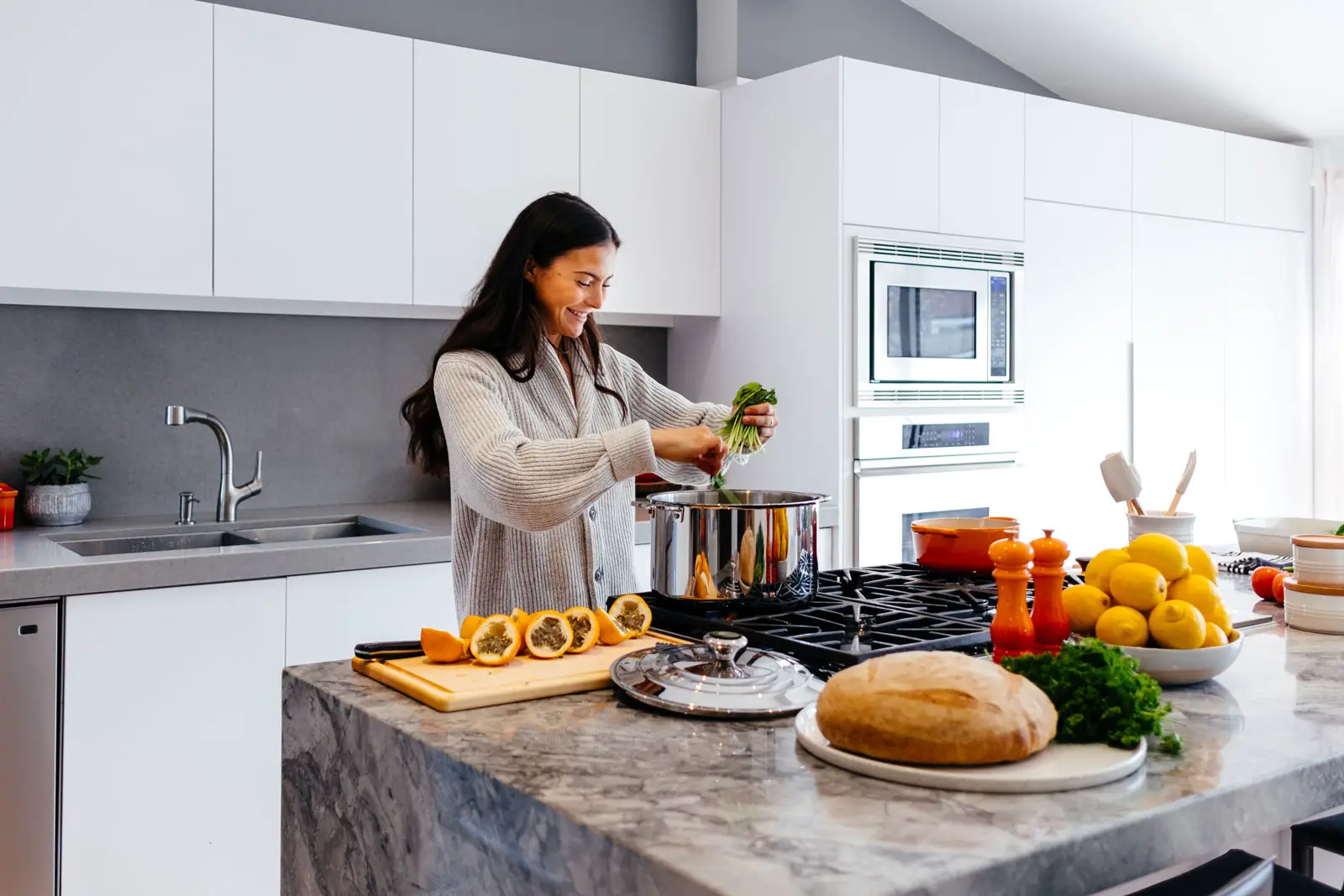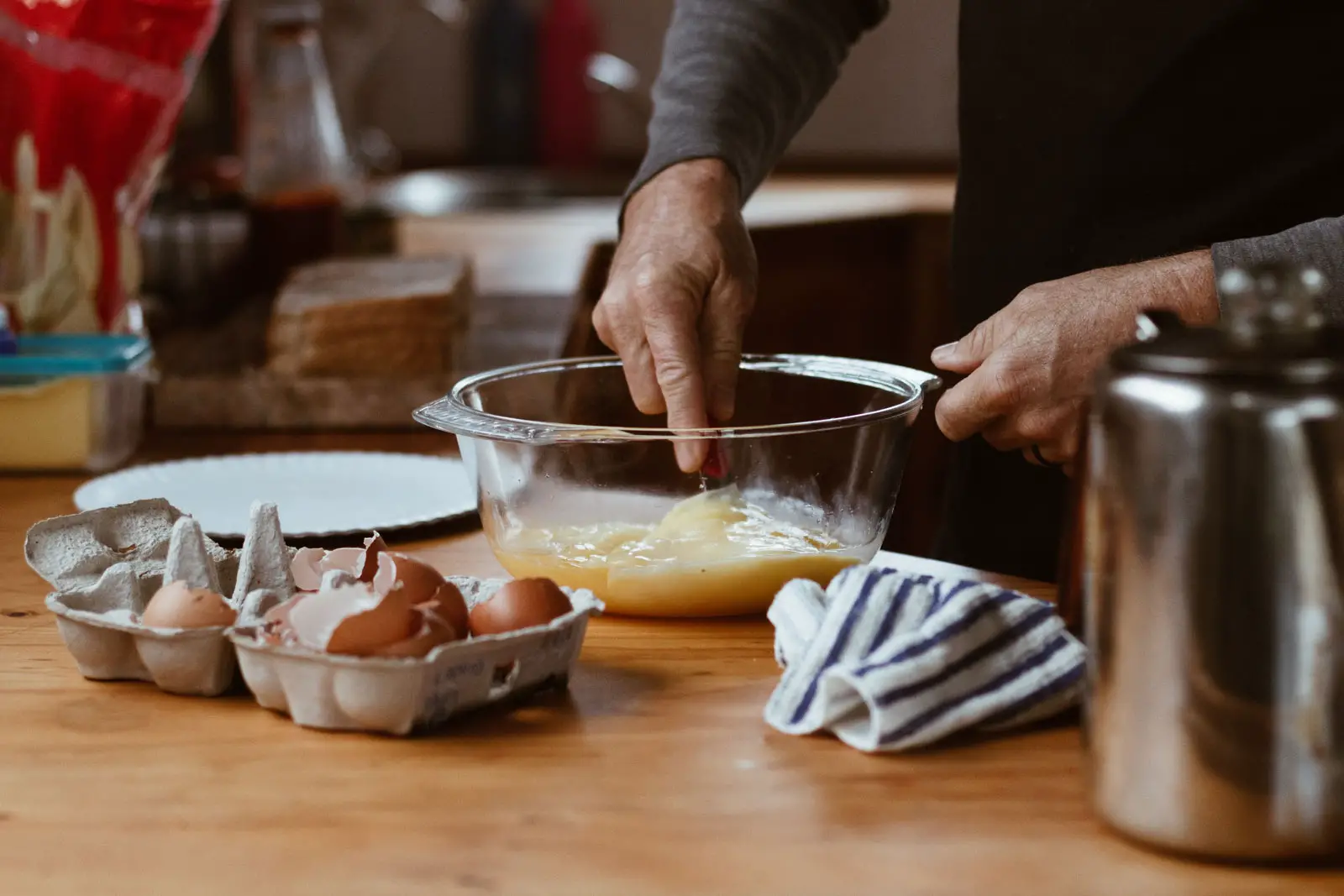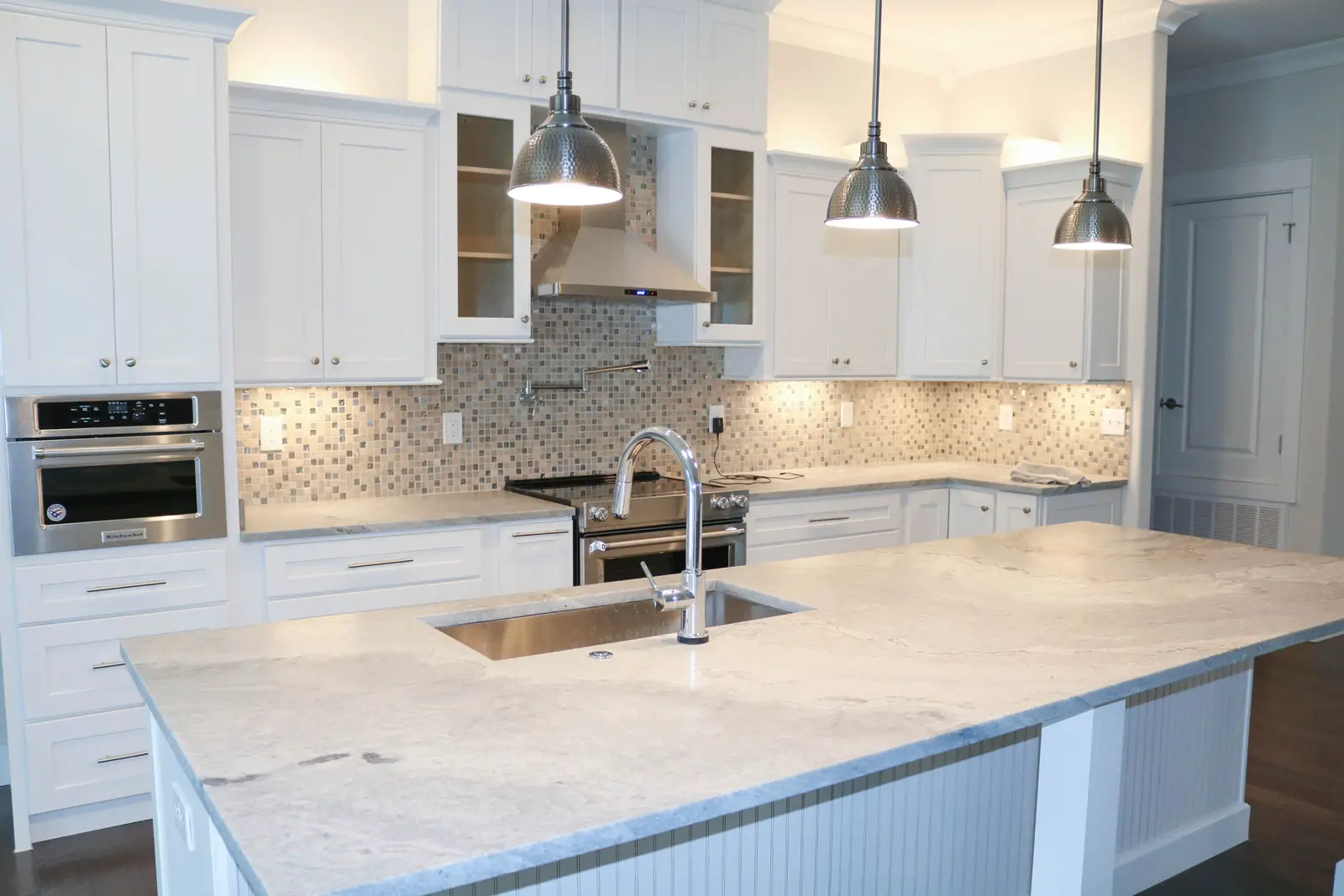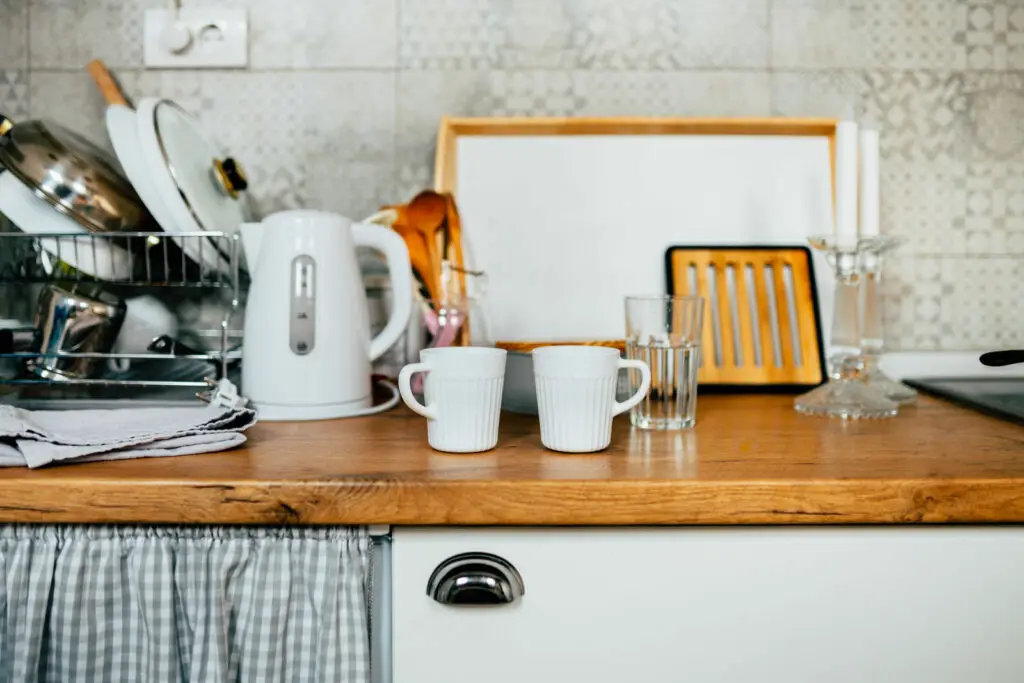Granite countertops are considered by some to be the “gold standard” for kitchen countertops, and many homeowners love the way it looks in their kitchen. But despite its durability and stylishness, granite is one of the more expensive countertop options.
But what if there was an equally durable and attractive alternative to a granite countertop that cost significantly less? Enter butcher block – a versatile and beautiful countertop material that not only looks great but can also save you money.
So how does a butcher block countertop compare to granite, both in terms of price and overall appearance?
The cost of a butcher block countertop versus a granite countertop can vary. Butcher block countertops on average cost between $30-$40 per square foot while granite countertops can cost between $50-$200 per square foot. The overall cost will depend on the specific type of wood chosen for the butcher block and the type of granite, as well as the size of the countertop and the location of the installation.
In this article, I’ll compare the cost of granite countertops to the cost of butcher block countertops, the pros, cons and the peculiarties of each so you can make an informed decision on what type of material is right for your kitchen.
By the way – before we get too far along here, if you want to connect with other homeowners and builders and get more great ideas for your home to make your space the best join my free private Facebook group, Remodel Reality here.

Cost Comparison of Butcher Block vs. Granite Countertops
Let’s start by comparing the cost per square foot of butcher block and granite countertops.
On average, butcher block countertops cost between $30-$40 per square foot, making them a more affordable option compared to granite or quartz countertops, which can cost anywhere from $50 to $200 or more per square foot.
However, it’s important to note that the cost of butcher block can vary depending on the type of wood used. Hardwoods such as maple, oak, cherry, and walnut are generally more expensive than more common woods like pine or birch.
The total cost of the job will depend on several factors. One of the most important is the size of the countertop.
A larger kitchen island or a complete kitchen remodel will naturally cost more than a smaller countertop replacement. Another important factor is the type of wood used. Hardwoods such as cherry or walnut are more expensive than softer woods like pine or birch, so if you opt for a more expensive type of wood, the overall cost of the job will be higher.
In terms of installation, butcher block countertops can be a DIY project for those with some woodworking experience.
But, if you don’t feel comfortable installing the countertop yourself, it’s recommended to have a professional installer handle the job. Proper installation is essential to ensure the longevity of the countertop, and a professional installation can cost anywhere from $200 to $1,000 or more, depending on the size of the job.
| Cost Factor | Butcher Block | Granite |
|---|---|---|
| Cost per Square Foot | $30-$40 | $40-$200 |
| Installation cost | $35-$85 per hour* | $35-$85 per hour* |
| Material hardness | Varies depending on the type of wood used, with some species being more expensive than others | Consistently hard and dense |
| Installation Method | DIY possible, but professional installation recommended | Professional installation required |
| Size of Countertop | Larger countertops increase the overall cost | Larger countertops increase the overall cost |
| Edge Profile | The cost of the edge profile will vary depending on the design | The cost of the edge profile will vary depending on the design |
| Slab Thickness | Thickness of the slab will affect the cost of the butcher block countertop | Thickness of the slab will affect the cost of the granite countertop |
| Complexity of the Design | Complex designs can increase the cost of the butcher block countertop | Complex designs can increase the cost of the granite countertop |
| Finish | Oiling and sealing are required to maintain the finish, increasing the overall cost | Polishing is required to maintain the finish, increasing the overall cost |
| Location | Costs will vary depending on the location, with prices being higher in urban areas | Costs will vary depending on the location, with prices being higher in urban areas |
| Delivery and Transportation | Delivery and transportation costs will vary depending on the location and size of the countertop | Delivery and transportation costs will vary depending on the location and size of the countertop |
*Installation costs may be included by some vendors

The Butcher Block Breakdown: An Overview
When it comes to new countertops, wood countertops are a great option for those looking for a lower cost alternative to granite. Butcher block surfaces offer a unique look and feel that can’t be found with other materials.
Plus, the cost of butcher block is much lower than granite or quartz. With so many different types of wood available, there’s sure to be an option that fits your style and budget.
Butcher block countertops are a popular choice for modern kitchen designs due to their unique look, warmth and organic appeal. They’re typically made from hardwood and cut from end grain and edge grain, making them versatile and durable surfaces.
Butcher block countertops are also a cost-effective option compared to materials like granite; on average, butcher block countertops cost less per square foot than other materials.
However, butcher block countertops can be sensitive to heat and require regular maintenance such as sealing and oiling in order to keep them in good condition. But, if you’re looking for a traditional or farmhouse kitchen design butcher block countertops are the perfect top for your counters.
There are several different types of woods that are commonly used for butcher block countertops:
Maple: Maple is one of the most popular choices for butcher block due to its hardness, durability, and light color.
Walnut: Walnut is a dense, hard wood with a rich, dark color that is often used for butcher block countertops.
Cherry: Cherry is a soft, warm-toned wood that is prized for its rich color and tight grain pattern.
Birch: Birch is a hard, durable wood that is similar in appearance to maple, but with a slightly tighter grain pattern.
Oak: Oak is a strong, hard wood with a distinctive, open grain pattern.
Mahogany: Mahogany is a dense, hard wood with a deep, rich color that is often used for butcher block countertops.
Teak: Teak is a strong, oily wood that is resistant to water and decay, making it a good choice for outdoor butcher block applications.
The Pros and Cons of Butcher Block Countertops
| Pros | Cons |
|---|---|
| Warm, natural appearance | Less durable than other countertop materials |
| More affordable compared to granite or quartz | Requires regular maintenance and sealing |
| Available in a wide variety of hardwoods with unique grain patterns | Can be scratched or damaged by heat or sharp objects |
| Can be sanded down to remove scratches or damage | Can be prone to water damage if not sealed properly |
| Great choice for traditional or farmhouse-style kitchens | May be less heat resistant than granite or quartz |
| Adds character and warmth to kitchen space | May require professional installation |
- Cost: On average, butcher block countertops cost between $30-$40 per square foot and are less expensive than granite or quartz countertops. However, the cost can go up to $100 or more per square foot and vary depending on the type of wood. The overall cost of the job will depend on size of the countertop and where it’s being installed.
- Material: Butcher block countertops are made of hardwoods, such as maple, oak, cherry, and walnut. They are constructed by gluing straight cuts of wood together, creating a solid surface that is ideal for food preparation.
- Installation: Butcher block countertops can be a DIY project, but it is recommended to have a professional installer handle the installation. Proper installation is essential to ensure the longevity of the countertop.
- Maintenance Requirements: Butcher block countertops require regular maintenance, including oiling and sealing, to keep them in good condition. A mineral oil should be applied to the surface of the countertop at least once a month to keep the wood hydrated and prevent cracking. Additionally, butcher block countertops should be sealed regularly to protect against water damage. The frequency of sealing will depend on the type of wood and how frequently the countertop is used.
 Granite Countertops Overview
Granite Countertops Overview
Granite countertops are a popular choice for kitchen surfaces due to their beauty, durability, and versatility. Made from natural stone, they offer a range of colors and patterns that can complement any kitchen design.
Granite countertops are kitchen surfaces made from slabs of granite, a type of natural stone. The stone is quarried from the earth, cut into slabs, and then polished to create a smooth, flat surface. Granite is one of the hardest and most durable materials used for kitchen countertops and is resistant to scratches, heat, and most types of damage.
Granite is a type of natural stone that is formed by the slow cooling and solidification of magma or lava. It is composed of quartz, feldspar, mica, and other minerals, and its unique pattern and coloration are determined by the combination of these minerals. The stone is quarried from the earth, cut into slabs, and then polished to create a smooth, flat surface.
Granite is a popular choice for kitchen countertops because of its beauty, durability, and versatility. It is available in a wide range of colors and patterns, allowing for a unique look in each kitchen. It is also resistant to scratches, heat, and most types of damage, making it a practical choice for a busy kitchen. Additionally, granite is easy to clean and maintain, and it is highly resistant to bacteria, making it a sanitary choice for food preparation.
The cost of granite countertops varies depending on the type of granite, the size of the kitchen, and the complexity of the installation. On average, the cost per square foot is around $50 to $100, with higher-end granites costing more. This is significantly more expensive than other materials, such as laminate or ceramic tile, but it is still a popular choice due to its durability and beauty.
Pros and Cons of Granite Countertops:
| Pros | Cons |
|---|---|
| Durable Material: Granite is a highly durable material that is resistant to scratches, chips, and stains. | Expensive: Granite countertops are often more expensive than other countertop options, including butcher block or laminate. |
| Heat Resistant: Granite can withstand high temperatures, making it a good choice for a kitchen where hot pots and pans are frequently used. | Heavy Weight: Granite slabs are heavy, which can make installation more challenging and may require additional support. |
| Low Maintenance: Granite is a low maintenance material that only requires occasional cleaning with a mild soap and water solution. | Professional Installation Required: Granite countertops require professional installation, which can add to the overall cost of the project. |
| Unique Look: Granite is a natural stone, so each slab is unique and offers a one-of-a-kind appearance. | Sealing Required: Granite countertops require regular sealing to prevent staining and protect the surface. |
| Scratch Resistant: Granite is a hard material that is resistant to scratches, making it a good choice for a kitchen that sees a lot of use. | Difficult to Repair: If granite is damaged, it can be difficult to repair and may require replacement of the entire slab. |
- Cost: Granite countertops, although pricier than butcher blocks with an average of $50-$100 per square foot, can get up to a staggering $200+ per square foot depending on the type and size. The cost of granite countertops also includes the cost of installation, which is typically performed by a professional.
- Material: Granite is a natural stone that is quarried from the earth. Each piece of granite is unique, with its own color variations, patterns, and veins. Granite is a popular choice for countertops due to its durability and resistance to heat and scratches.
- Installation: Professional installation is necessary for granite countertops, as the process can be complex and requires specialized tools. The installation process typically takes a few days and involves measuring and cutting the granite to fit the specific dimensions of the kitchen, as well as securing the countertop in place.
- Maintenance Requirements: Granite countertops are relatively low maintenance compared to butcher block countertops. They only need to be cleaned with mild soap and water, and they are resistant to bacteria and staining. However, granite countertops should be sealed every few years to protect against spills and stains.
Frequently Asked Questions
What is the difference in durability between butcher block and granite countertops?
Butcher block countertops can be more susceptible to scratches and cuts, but they can be sanded down and resealed to restore their surface. Granite is a harder material and is less likely to scratch or chip, but it is also more prone to cracks and chips if something heavy is dropped on it.
How does the installation process differ for butcher block and granite countertops?
Butcher block countertops can be a DIY project, but it is recommended to have a professional installer handle the installation. Proper installation is essential to ensure the longevity of the countertop. Granite countertops are typically installed by professionals and require more specialized tools and techniques to complete the job.
How do maintenance requirements compare between butcher block and granite countertops?
Butcher block countertops require regular maintenance, including oiling and sealing, to keep them in good condition. Granite countertops are lower maintenance and only require occasional cleaning and sealing.
Can butcher block countertops be used for outdoor kitchens?
Butcher block countertops can be used for outdoor kitchens, but they need to be treated with a waterproof sealant and protected from exposure to the elements. Granite countertops are not recommended for outdoor use as they are not as durable in harsh weather conditions.
Can you use butcher block countertops as a cutting board without ruining them?
Yes, butcher block is the only countertop cutting surface that will not dull your damage your blades and can be used for food preparation. Regular maintenance is essential to keep the butcher block in good condition and prevent damage from prolonged use as a cutting board.
How do the aesthetics compare between butcher block and granite countertops?
Butcher block countertops have a warm, natural look and can add character to a kitchen. Granite countertops come in a variety of colors and patterns, but they have a more uniform, polished look.
What is the life span of a butcher block countertop compared to granite?
With proper maintenance and care, a butcher block countertop can last for several decades. Granite countertops are more durable and can last for many years, but the life span will depend on the quality of the granite and how it is treated.
Are butcher block countertops more environmentally friendly than granite countertops?
Butcher block countertops are made of renewable hardwoods and are often sourced from sustainable forests. Granite countertops are made from mined stone, and the process of extracting and processing the granite can have a negative impact on the environment. Additionally, granite countertops are often shipped from overseas, contributing to carbon emissions from transportation.
Next Steps
Want to join others who are creating the most amazing home redesigns & renovations and get more tips, tricks and hacks on how to make your home the best it can be?
Join my brand new free private Facebook group, Remodel Reality to connect with other people like you to make your space the best!






